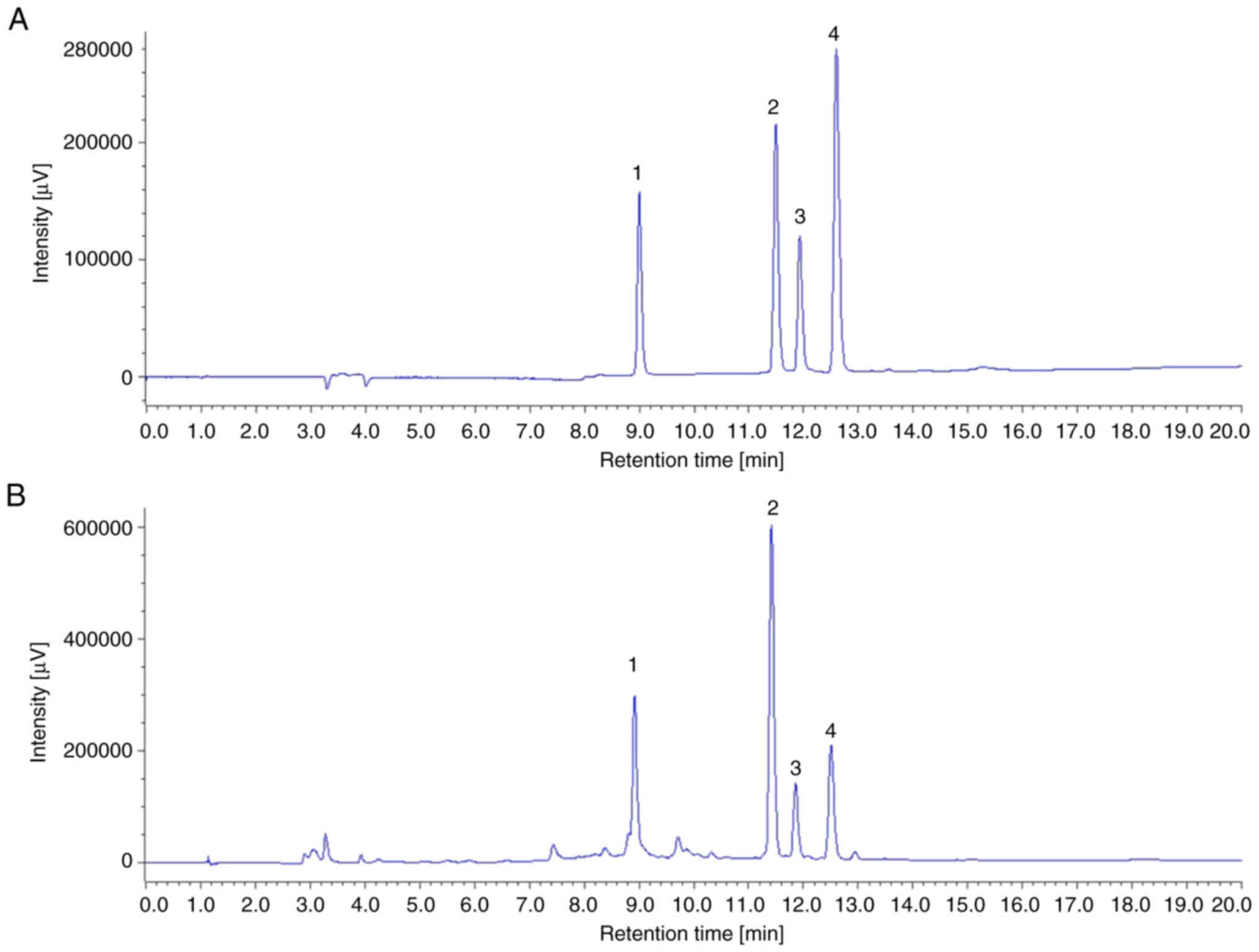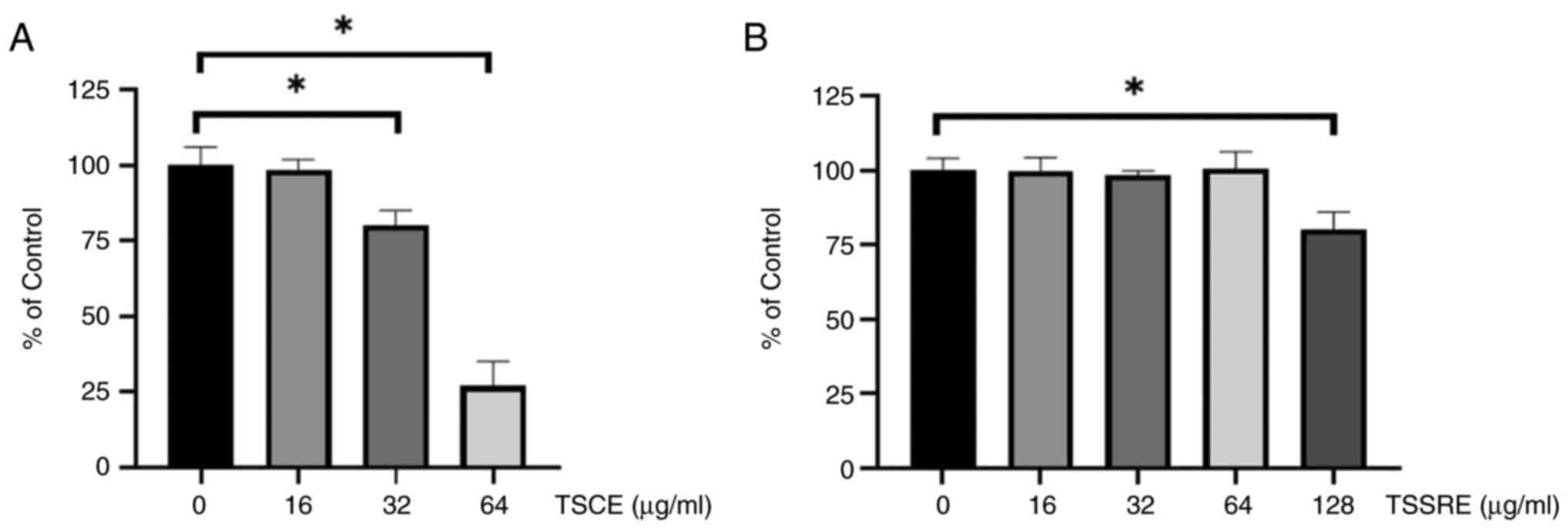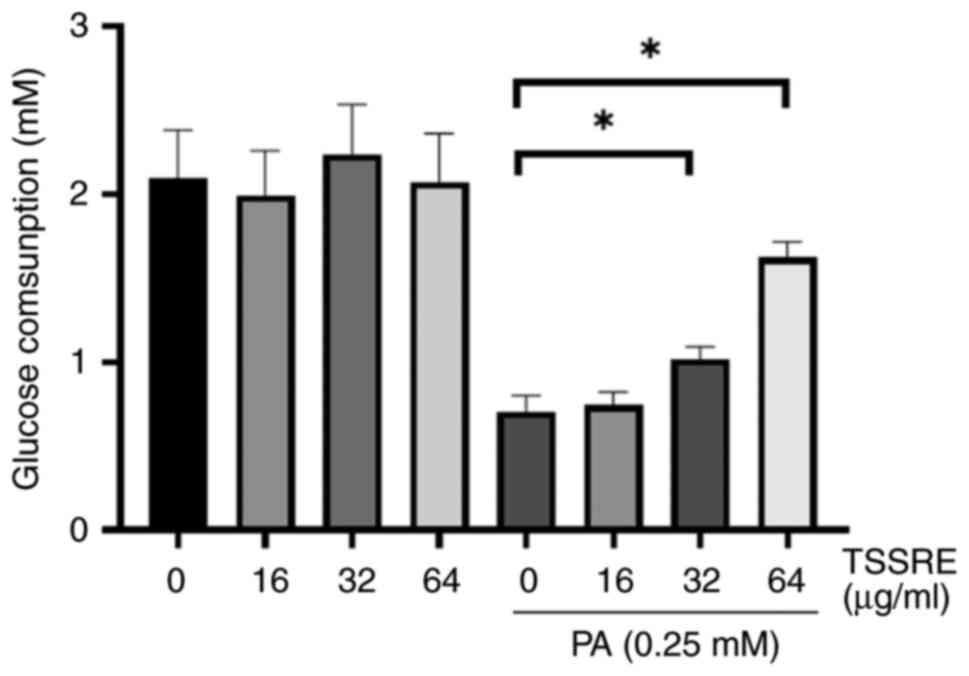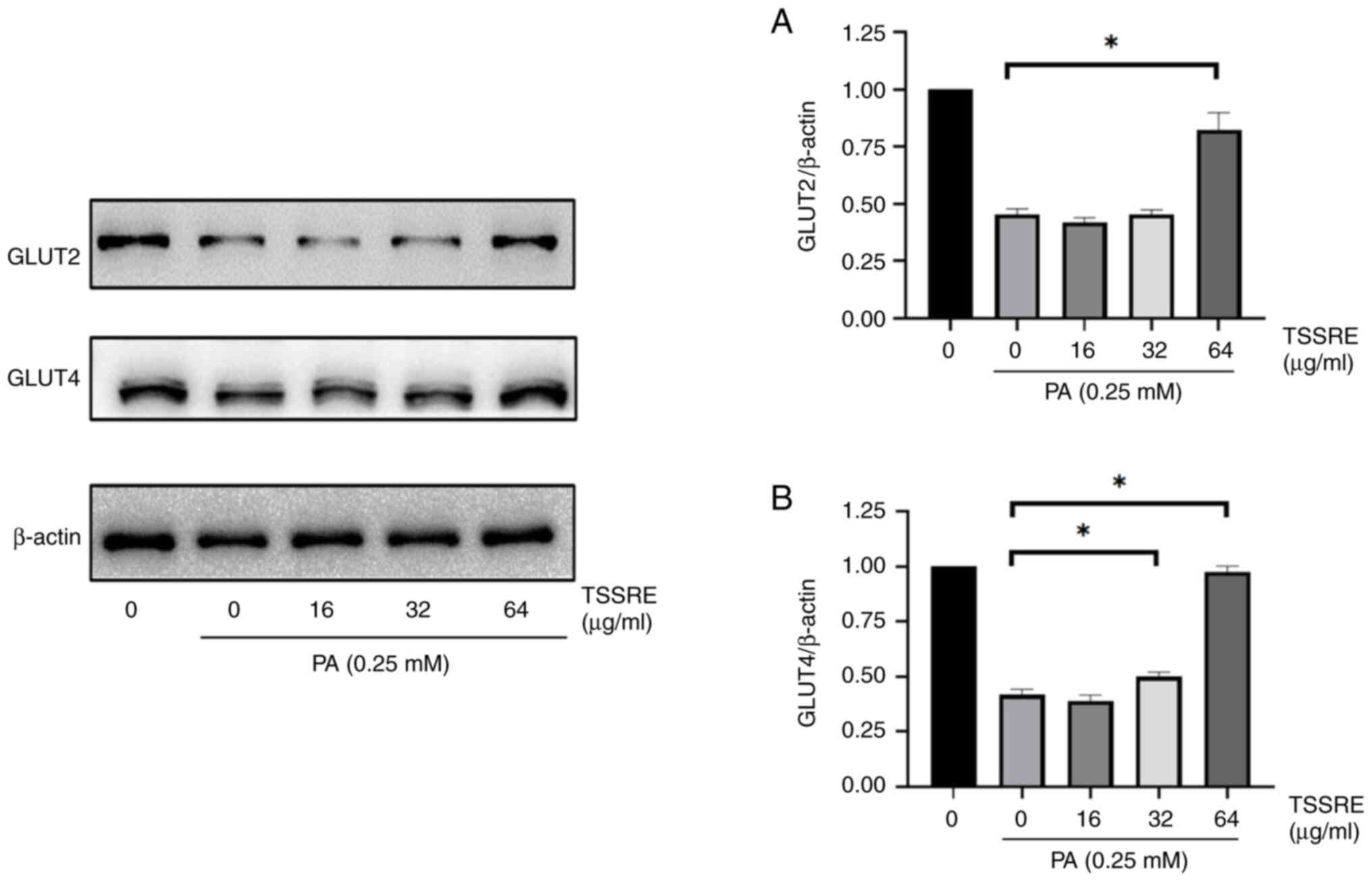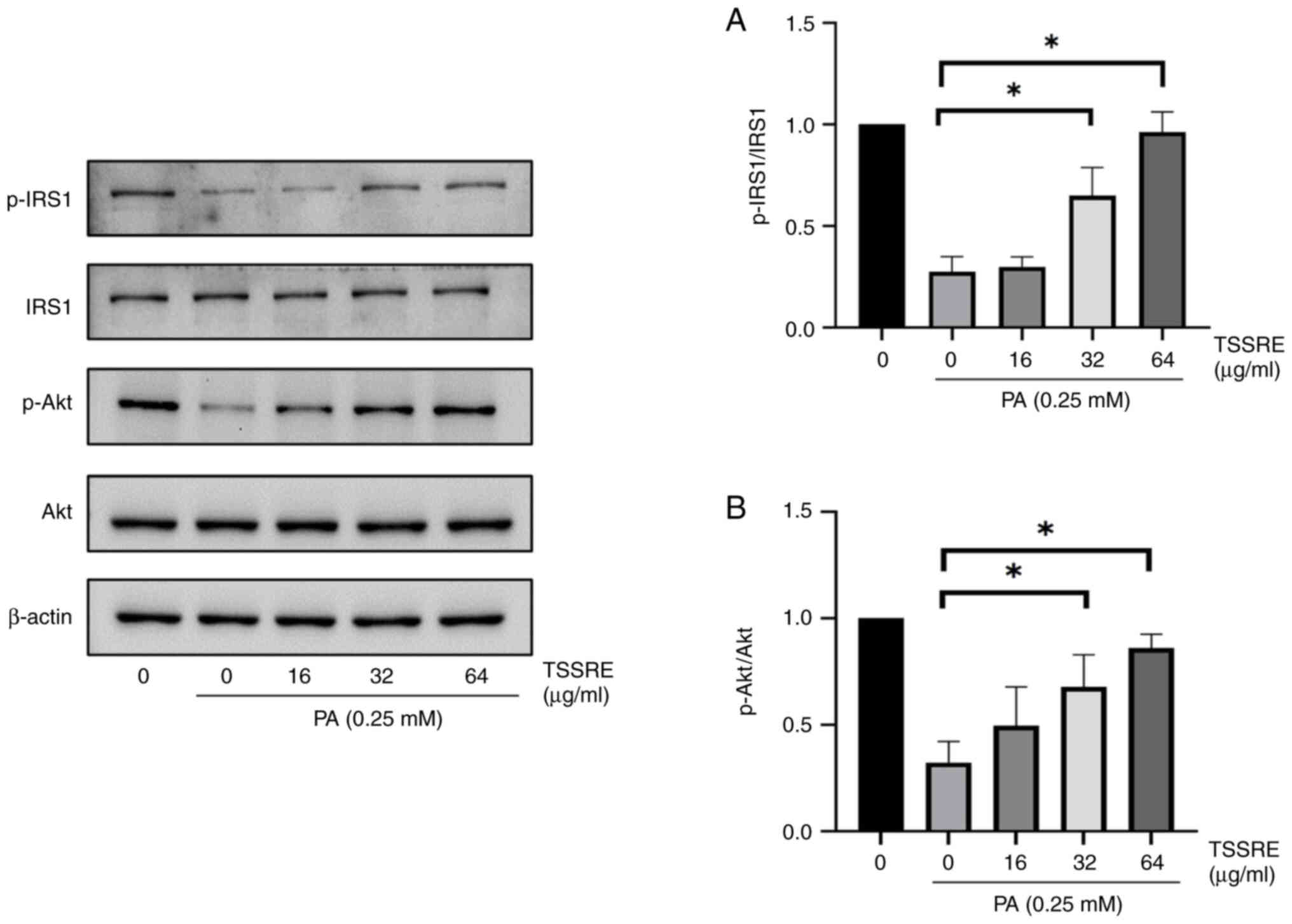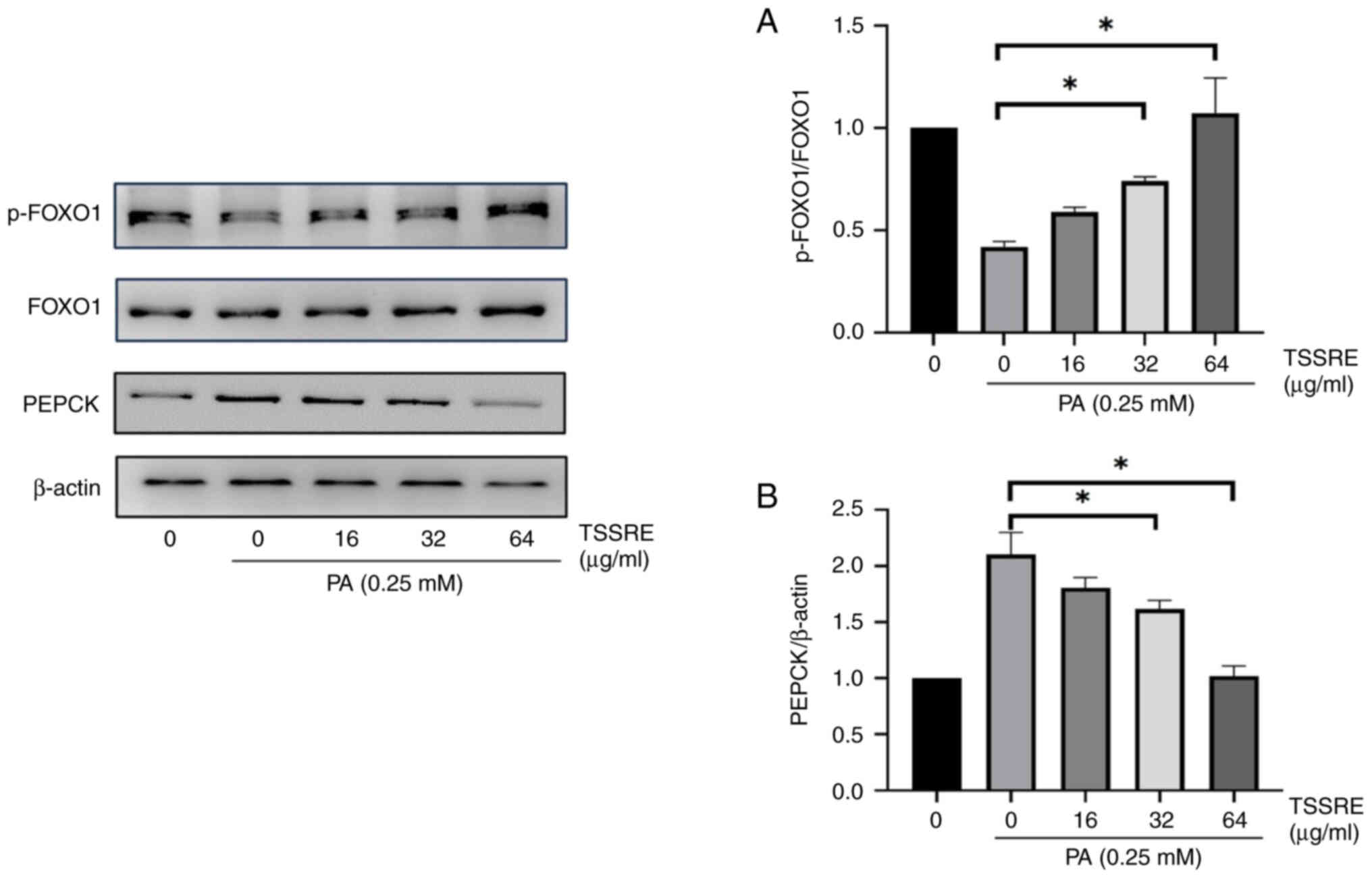|
1
|
Barquilla García A: Brief update on
diabetes for general practitioners. Rev Esp Sanid Penit. 19:57–65.
2017.PubMed/NCBI
|
|
2
|
Ashcroft FM and Rorsman P: Diabetes
mellitus and the β cell: The last ten years. Cell. 148:1160–1171.
2012. View Article : Google Scholar : PubMed/NCBI
|
|
3
|
Chatterjee S, Khunti K and Davies MJ: Type
2 diabetes. Lancet. 389:2239–2251. 2017. View Article : Google Scholar : PubMed/NCBI
|
|
4
|
Xin Y and Wang Y, Chi J, Zhu X, Zhao H,
Zhao S and Wang Y: Elevated free fatty acid level is associated
with insulin-resistant state in nondiabetic Chinese people.
Diabetes Metab Syndr Obes. 12:139–147. 2019. View Article : Google Scholar : PubMed/NCBI
|
|
5
|
Honka MJ, Latva-Rasku A, Bucci M, Virtanen
KA, Hannukainen JC, Kalliokoski KK and Nuutila P:
Insulin-stimulated glucose uptake in skeletal muscle, adipose
tissue and liver: A positron emission tomography study. Eur J
Endocrinol. 178:523–531. 2018. View Article : Google Scholar : PubMed/NCBI
|
|
6
|
Aldhoon-Hainerová I, Zamrazilová H,
Dušátková L, Sedláčková B, Hlavatý P, Hill M, Hampl R, Kunešová M
and Hainer V: Glucose homeostasis and insulin resistance:
Prevalence, gender differences and predictors in adolescents.
Diabetol Metab Syndr. 6:1002014. View Article : Google Scholar : PubMed/NCBI
|
|
7
|
Boden G: 45Obesity, insulin resistance and
free fatty acids. Curr Opin Endocrinol Diabetes Obes. 18:139–143.
2011. View Article : Google Scholar : PubMed/NCBI
|
|
8
|
Šrámek J, Němcová-Fürstová V and Kovář J:
Kinase signaling in apoptosis induced by saturated fatty acids in
pancreatic β-cells. Int J Mol Sci. 17:14002016. View Article : Google Scholar : PubMed/NCBI
|
|
9
|
Lawan A and Bennett AM: Mitogen-activated
protein kinase regulation in hepatic metabolism. Trends Endocrinol
Metab. 28:868–878. 2017. View Article : Google Scholar : PubMed/NCBI
|
|
10
|
Shin J, Fukuhara A, Onodera T, Kita S,
Yokoyama C, Otsuki M and Shimomura I: SDF-1 is an autocrine
insulin-desensitizing factor in adipocytes. Diabetes. 67:1068–1078.
2018. View Article : Google Scholar : PubMed/NCBI
|
|
11
|
Bengal E, Aviram S and Hayek T: p38 MAPK
in glucose metabolism of skeletal muscle: Beneficial or harmful?
Int J Mol Sci. 21:64802020. View Article : Google Scholar : PubMed/NCBI
|
|
12
|
Feng J, Lu S, Ou B, Liu Q, Dai J, Ji C,
Zhou H, Huang H and Ma Y: The role of JNk signaling pathway in
obesity-driven insulin resistance. Diabetes Metab Syndr Obes.
13:1399–1406. 2020. View Article : Google Scholar : PubMed/NCBI
|
|
13
|
Cross DA, Alessi DR, Cohen P, Andjelkovich
M and Hemmings BA: Inhibition of glycogen synthase kinase-3 by
insulin mediated by protein kinase B. Nature. 378:785–789. 1995.
View Article : Google Scholar : PubMed/NCBI
|
|
14
|
Taniguchi CM, Emanuelli B and Kahn CR:
Critical nodes in signalling pathways: Insights into insulin
action. Nat Rev Mol Cell Biol. 7:85–96. 2006. View Article : Google Scholar : PubMed/NCBI
|
|
15
|
Guo S: Molecular basis of insulin
resistance: The role of IRS and Foxo1 in the control of diabetes
mellitus and its complications. Drug Discov Today Dis Mech.
10:e27–e33. 2013. View Article : Google Scholar : PubMed/NCBI
|
|
16
|
Yūko K: The spread of tea from Taiwan and
the Chinese distribution network in colonial java. Mem Res Dep Toyo
Bunko. 77:39–64. 2019.
|
|
17
|
Aboulwafa MM, Youssef FS, Gad HA, Altyar
AE, Al-Azizi MM and Ashour ML: A comprehensive insight on the
health benefits and phytoconstituents of Camellia sinensis
and recent approaches for its quality control. Antioxidants
(Basel). 8:4552019. View Article : Google Scholar : PubMed/NCBI
|
|
18
|
Zeng W and Endo Y: Lipid characteristics
of camellia seed oil. J Oleo Sci. 68:649–658. 2019. View Article : Google Scholar : PubMed/NCBI
|
|
19
|
Shen J, Zhang Z, Tian B and Hua Y:
Lipophilic phenols partially explain differences in the antioxidant
activity of subfractions from methanol extract of camellia oil. Eur
Food Res Technol. 235:1071–1082. 2012. View Article : Google Scholar : PubMed/NCBI
|
|
20
|
Park JS, Yeom MH, Park WS, Joo KM, Rho HS,
Kim DH and Chang IS: Enzymatic hydrolysis of green tea seed extract
and its activity on 5alpha-reductase inhibition. Biosci Biotechnol
Biochem. 70:387–394. 2006. View Article : Google Scholar : PubMed/NCBI
|
|
21
|
Yeh TM, Chang CD, Liu SS, Chang CI and
Shih WL: Tea seed kaempferol triglycoside attenuates LPS-induced
systemic inflammation and ameliorates cognitive impairments in a
mouse model. Molecules. 27:20552022. View Article : Google Scholar : PubMed/NCBI
|
|
22
|
Chen FC, Shen KP, Ke LY, Lin HL, Wu CC and
Shaw SY: Flavonoids from Camellia sinensis (L.) O. Kuntze
seed ameliorates TNF-α induced insulin resistance in HepG2 cells.
Saudi Pharm J. 27:507–516. 2019. View Article : Google Scholar : PubMed/NCBI
|
|
23
|
Fu G, Chen K, Wang J, Wang M, Li R, Wu X,
Wu C, Zhang P, Liu C and Wan Y: Screening of tea saponin-degrading
strain to degrade the residual tea saponin in tea seed cake. Prep
Biochem Biotechnol. 50:697–707. 2020. View Article : Google Scholar : PubMed/NCBI
|
|
24
|
Chaicharoenpong C: Tea (Camellia
oleifera) seeds: Use of tea seeds in human health. Nuts and
Seeds in Health and Disease Prevention. Elsevier; pp. 299–313.
2020, View Article : Google Scholar
|
|
25
|
Ohta T, Nakamura S, Matsumoto T, Nakashima
S, Ogawa K, Matsumoto T, Fukaya M, Yoshikawa M and Matsuda H:
Chemical structure of an acylated oleanane-type triterpene
oligoglycoside and anti-inflammatory constituents from the flower
buds of Camellia sinensis. Nat Prod Commun. 12:1193–1196.
2017.
|
|
26
|
Fan L, He Y, Xu Y, Li P, Zhang J and Zhao
J: Triterpenoid saponins in tea (Camellia sinensis) plants:
Biosynthetic gene expression, content variations, chemical
identification and cytotoxicity. Int J Food Sci Nutr. 72:308–323.
2021. View Article : Google Scholar : PubMed/NCBI
|
|
27
|
Diwan F, Abdel Hassan I and Mohammed S:
Effect of saponin on mortality and histopathological changes in
mice. East Mediterr Health J. 6:345–351. 2000. View Article : Google Scholar : PubMed/NCBI
|
|
28
|
Yu Z, Hong H, Xing N, Xi H and Jiang H:
Comparison of bio-fermentation and chemical method in the
improvement of the quality of oil-tea Camellia seed meal. China
Oils Fats. 35:40–43. 2010.
|
|
29
|
Lai LR, Hsieh SC, Huang HY and Chou CC:
Effect of lactic fermentation on the total phenolic, saponin and
phytic acid contents as well as anti-colon cancer cell
proliferation activity of soymilk. J Biosci Bioeng. 115:552–556.
2013. View Article : Google Scholar : PubMed/NCBI
|
|
30
|
Nagy M and Grancai D: Colorimetric
determination of flavanones in propolis. Pharmazie. 51:100–101.
1996.
|
|
31
|
Woisky RG and Salatino A: Analysis of
propolis: Some parameters and procedures for chemical quality
control. J Apic Res. 37:99–105. 1998. View Article : Google Scholar
|
|
32
|
Zhang Y, Yan LS, Ding Y, Cheng BCY, Luo G,
Kong J, Liu TH and Zhang SF: Edgeworthia gardneri (Wall.) Meisn.
water extract ameliorates palmitate induced insulin resistance by
regulating IRS1/GSK3β/FoxO1 signaling pathway in human HepG2
hepatocytes. Front Pharmacol. 10:16662020. View Article : Google Scholar : PubMed/NCBI
|
|
33
|
Alnahdi A, John A and Raza H: Augmentation
of glucotoxicity, oxidative stress, apoptosis and mitochondrial
dysfunction in HepG2 cells by palmitic acid. Nutrients.
11:19792019. View Article : Google Scholar : PubMed/NCBI
|
|
34
|
Cholkar K, Ray A, Agrahari V, Pal D and
Mitra AK: Transporters and receptors in the anterior segment of the
eye. Ocular Transporters and Receptors. Elsevier; pp. 115–168.
2013, View Article : Google Scholar
|
|
35
|
Croniger CM, Olswang Y, Reshef L, Kalhan
SC, Tilghman SM and Hanson RW: Mini-series: Modern metabolic
concepts phosphoenolpyruvate carboxykinase revisited. Biochem Mol
Biol Educ. 30:14–20. 2002. View Article : Google Scholar
|
|
36
|
Chen Y, Gao Y, Han Z and Yin J: Analysis
of the saponin contents and composition in tea seeds of different
germplasms. J Tea Sci. 42:705–716. 2022.
|
|
37
|
Soltani M, Parivar K, Baharara J,
Kerachian MA and Asili J: Hemolytic and cytotoxic properties of
saponin purified from Holothuria leucospilota sea cucumber. Rep
Biochem Mol Biol. 3:43–50. 2014.PubMed/NCBI
|
|
38
|
Dong Z, Sun T, Liang L and Wang L: Effect
of tea saponin on ephyrae and polyps of the moon jellyfish Aurelia
sp.1. PLoS One. 12:e01827872017. View Article : Google Scholar : PubMed/NCBI
|
|
39
|
Ahmed H, Mariod A and Hammoda T: The
chronic toxicity studies of camellia seed oil containing tea
saponins on mice blood and organs. Int J Life Sci Biotechnol.
4:178–191. 2021. View Article : Google Scholar
|
|
40
|
Waheed Janabi AH, Kamboh AA, Saeed M,
Xiaoyu L, BiBi J, Majeed F, Naveed M, Mughal MJ, Korejo NA, Kamboh
R, et al: Flavonoid-rich foods (FRF): A promising nutraceutical
approach against lifespan-shortening diseases. Iran J Basic Med
Sci. 23:140–153. 2020.PubMed/NCBI
|
|
41
|
Termkwancharoen C, Malakul W,
Phetrungnapha A and Tunsophon S: Naringin ameliorates skeletal
muscle atrophy and improves insulin resistance in
high-fat-diet-induced insulin resistance in obese rats. Nutrients.
14:41202022. View Article : Google Scholar : PubMed/NCBI
|
|
42
|
Wen L, Wu D, Tan X, Zhong M, Xing J, Li W,
Li D and Cao F: The role of catechins in regulating diabetes: An
update review. Nutrients. 14:46812022. View Article : Google Scholar : PubMed/NCBI
|
|
43
|
Russo B, Picconi F, Malandrucco I and
Frontoni S: Flavonoids and insulin-resistance: From molecular
evidences to clinical trials. Int J Mol Sci. 20:20612019.
View Article : Google Scholar : PubMed/NCBI
|
|
44
|
Al-Ishaq RK, Abotaleb M, Kubatka P, Kajo K
and Büsselberg D: Flavonoids and their anti-diabetic effects:
Cellular mechanisms and effects to improve blood sugar levels.
Biomolecules. 9:4302019. View Article : Google Scholar : PubMed/NCBI
|
|
45
|
Gołąbek KD and Regulska-Ilow B: Dietary
support in insulin resistance: An overview of current scientific
reports. Adv Clin Exp Med. 28:1577–1585. 2019. View Article : Google Scholar : PubMed/NCBI
|
|
46
|
Carta G, Murru E, Banni S and Manca C:
Palmitic acid: Physiological role, metabolism and nutritional
implications. Front Physiol. 8:9022017. View Article : Google Scholar : PubMed/NCBI
|
|
47
|
Sánchez-Alegría K, Bastián-Eugenio CE,
Vaca L and Arias C: Palmitic acid induces insulin resistance by a
mechanism associated with energy metabolism and calcium entry in
neuronal cells. FASEB J. 35:e217122021. View Article : Google Scholar : PubMed/NCBI
|
|
48
|
Brown G: Glucose transporters: Structure,
function and consequences of deficiency. J Inherit Metab Dis.
23:237–246. 2000. View Article : Google Scholar : PubMed/NCBI
|
|
49
|
D'Alessandris C, Lauro R, Presta I and
Sesti G: C-reactive protein induces phosphorylation of insulin
receptor substrate-1 on Ser307 and Ser 612 in L6 myocytes, thereby
impairing the insulin signalling pathway that promotes glucose
transport. Diabetologia. 50:840–849. 2007. View Article : Google Scholar : PubMed/NCBI
|
|
50
|
White MF: Insulin signaling in health and
disease. Science. 302:1710–1711. 2003. View Article : Google Scholar : PubMed/NCBI
|
|
51
|
Koren-Gluzer M, Aviram M and Hayek T:
Paraoxonase1 (PON1) reduces insulin resistance in mice fed a
high-fat diet, and promotes GLUT4 overexpression in myocytes, via
the IRS-1/Akt pathway. Atherosclerosis. 229:71–78. 2013. View Article : Google Scholar : PubMed/NCBI
|
|
52
|
Petersen MC, Vatner DF and Shulman GI:
Regulation of hepatic glucose metabolism in health and disease. Nat
Rev Endocrinol. 13:572–587. 2017. View Article : Google Scholar : PubMed/NCBI
|
|
53
|
Ren Z, Xie Z, Cao D, Gong M, Yang L, Zhou
Z and Ou Y: C-Phycocyanin inhibits hepatic gluconeogenesis and
increases glycogen synthesis via activating Akt and AMPK in insulin
resistance hepatocytes. Food Funct. 9:2829–2839. 2018. View Article : Google Scholar : PubMed/NCBI
|
|
54
|
Hatting M, Tavares CDJ, Sharabi K, Rines
AK and Puigserver P: Insulin regulation of gluconeogenesis. Ann N Y
Acad Sci. 1411:21–35. 2018. View Article : Google Scholar : PubMed/NCBI
|
|
55
|
Murray B and Rosenbloom C: Fundamentals of
glycogen metabolism for coaches and athletes. Nutr Rev. 76:243–259.
2018. View Article : Google Scholar : PubMed/NCBI
|
|
56
|
Sullivan MA and Forbes JM: Glucose and
glycogen in the diabetic kidney: Heroes or villains? EBioMedicine.
47:590–597. 2019. View Article : Google Scholar : PubMed/NCBI
|
|
57
|
Kamiyama M, Naguro I and Ichijo H: In vivo
gene manipulation reveals the impact of stress-responsive MAPK
pathways on tumor progression. Cancer Sci. 106:785–796. 2015.
View Article : Google Scholar : PubMed/NCBI
|
|
58
|
Yudhani RD, Sari Y, Nugrahaningsih DAA,
Sholikhah EN, Rochmanti M, Purba AKR, Khotimah H, Nugrahenny D and
Mustofa M: In vitro insulin resistance model: A recent update. J
Obes. 2023:19647322023. View Article : Google Scholar : PubMed/NCBI
|



